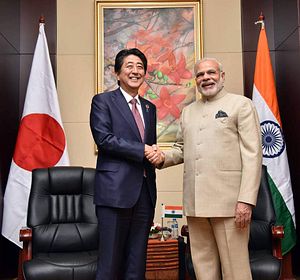On Sunday, the Times of India, quoting a Japanese diplomatic official, reported that Japan would like to see India take a clearer and more vocal stance on the South China Sea disputes. According to the report, Yuki Tamura, deputy director of Japan foreign ministry’s regional policy division, said that Japan was “encouraging India to speak up on issues related to South China Sea because maritime security is important.”
India and Japan have been steadily converging strategically and have shared what they call a “Strategic and Global Partnership” since 2006. Over recent years, as the South China Sea disputes have heated up, both countries have taken an active interest, despite their lack of geographic proximity to the immediate South China Sea littoral.
The comments coming out of Tokyo on India’s position on the South China Sea are unsurprising. Japan shares its own dispute with China over the Senkaku/Diaoyu Islands in the East China Sea, but has taken an active interest in the South China Sea, where it backs the United States, its treaty ally, in standing up for universal norms, including international law, the peaceful management of disputes, and freedom of navigation and overflight.
India, meanwhile, has spoken out on the South China Sea on several occasions, including in joint statements with the United States, Vietnam, and even Japan. Indian and Japanese prime ministers meet annually for bilateral summits and at last year’s meeting, Narendra Modi and Shinzo Abe “called upon all States to avoid unilateral actions that could lead to tensions in the region.”
The two leaders are scheduled to meet again later this year. This year’s summit will hold particular significance for observers who’ve long followed this relationship as there are signs that the two countries may conclude a long-pending civil nuclear cooperation deal and may even cinch a defense deal for the transfer of US-2 amphibious search and rescue aircraft from Japan to India. (Incidentally, the defense deal would be Japan’s first ever since the lifting of its self-imposed ban on weapons exports.)
India’s position on the South China Sea generally aligns with that of the United States and Japan, but New Delhi has not gone as far as Tokyo and Washington. For instance, India diverges with the United States and Tokyo in its position on the July 12 ruling by a five-judge tribunal at the Permanent Court of Arbitration in The Hague, which found China’s capacious nine-dashed line and other activities in the South China Sea at odds with international law.
India, which resolved a dispute of its own with Bangladesh in 2014 through an UNCLOS tribunal, welcomed the ruling, but did not describe it as binding and call for it to be respected. Japan, in fact, is the only non-Western and non-claimant state to call for the ruling to be respected. (Vietnam, a South China Sea claimant, has also called on both parties to the dispute — Philippines and China — to respect the ruling.)
New Delhi has its own interests in the South China Sea, which it treats as a “secondary area” of maritime interest according to last year’s maritime strategy. Earlier in 2015, before the ruling, India signed on to a trilateral statement with Russia and China that called on the disputes in the region be resolved through bilateral consultation, per China’s preference. Since then, Delhi has recalibrated its position, support international law.
It’ll be interesting to see if Japan’s increasing enthusiasm for India playing an activist role on the South China Sea issue is met with openness in New Delhi. Generally, India does not take kindly to external countries dictating its messaging. In particular, India’s concerns with the land border dispute and other issues with China — including membership in the Nuclear Suppliers Group and proscribing terrorists like Masood Azhar at the United Nations — may drive its messaging on the South China Sea. (See Srinath Raghavan’s recent article in the Hindustan Times for one perspective on why Delhi may want to rethink growing involvement in the South China Sea disputes.)
Though India’s maritime strategy has described the South China Sea as a zone of “secondary interest” — secondary to immediate concerns in the Arabian Sea and the Bay of Bengal, at least — New Delhi has reasons to support freedom of navigation in the region and prevent Chinese hegemony from taking hold. For instance, Chinese military dominance in the South China Sea offers the People’s Liberation Army-Navy a formidable launching pad for more frequent operations into the Bay of Bengal and the eastern Indian Ocean, threatening Indian interests.
Meanwhile, for Japan, its interest in the South China Sea is here to stay, despite China treating growing Japanese involvement in the area as a threat to its core interests. In September 2016, Japan’s defense minister, Tomomi Inada, clarified Tokyo’s plans for expanded naval involvement in the region and this is likely to intensify in 2017 and beyond.
Following with last year’s precedent, it’s very likely that we’ll get another paragraph on the South China Sea this year when Abe meets Modi. It’ll be worth keeping an eye out for how this year’s language changes. In particular, if Tokyo can convince New Delhi to take a stronger position on the July ruling and include it in the statement, that’ll represent an important turning point.

































